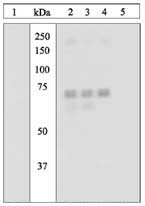527460 Sigma-AldrichPhosphoDetect™ Anti-PKR (pThr⁴⁵¹) Rabbit pAb
This PhosphoDetect™ Anti-PKR (pThr⁴⁵¹) Rabbit pAb is validated for use in Immunoblotting, Immunohistochemistry for the detection of PKR (pThr⁴⁵¹).
More>> This PhosphoDetect™ Anti-PKR (pThr⁴⁵¹) Rabbit pAb is validated for use in Immunoblotting, Immunohistochemistry for the detection of PKR (pThr⁴⁵¹). Less<<同義語: Anti-Double-stranded RNA-dependent Protein Kinase, Phospho-Specific (Thr⁴⁵¹)
お勧めの製品
概要
| Replacement Information |
|---|
主要スペック表
| Species Reactivity | Host | Antibody Type |
|---|---|---|
| H, M | Rb | Polyclonal Antibody |
価格&在庫状況
| カタログ番号 | 在庫状況 | 包装 | Qty/Pk | 価格 | 数量 | |
|---|---|---|---|---|---|---|
| 527460-10TCN |
|
樹脂アンプル | 10 t |
|
— |
| References | |
|---|---|
| References | Cuddihy, A.R., et al.1999. Oncogene 8, 2690. Srivastava, S.P., et al. 1998. J. Biol. Chem. 273, 2416. Clemens, M.J. 1997. Int. J. Biochem. Cell Biol. 29, 945. |
| Product Information | |
|---|---|
| Form | Liquid |
| Formulation | In Dulbecco's PBS (without Mg+2 or Ca+2), 0.1% BSA, 50% glycerol, pH 7.3. |
| Positive control | IFNγ-stimulated HeLa cells. |
| Preservative | ≤0.1% sodium azide |
| Quality Level | MQ100 |
| Physicochemical Information |
|---|
| Dimensions |
|---|
| Materials Information |
|---|
| Toxicological Information |
|---|
| Safety Information according to GHS |
|---|
| Safety Information |
|---|
| Product Usage Statements |
|---|
| Packaging Information |
|---|
| Transport Information |
|---|
| Supplemental Information |
|---|
| Specifications |
|---|
| Global Trade Item Number | |
|---|---|
| カタログ番号 | GTIN |
| 527460-10TCN | 04055977270396 |
Documentation
PhosphoDetect™ Anti-PKR (pThr⁴⁵¹) Rabbit pAb (M)SDS
| タイトル |
|---|
PhosphoDetect™ Anti-PKR (pThr⁴⁵¹) Rabbit pAb 試験成績書(CoA)
| タイトル | ロット番号 |
|---|---|
| 527460 |
参考資料
| 参考資料の概要 |
|---|
| Cuddihy, A.R., et al.1999. Oncogene 8, 2690. Srivastava, S.P., et al. 1998. J. Biol. Chem. 273, 2416. Clemens, M.J. 1997. Int. J. Biochem. Cell Biol. 29, 945. |












